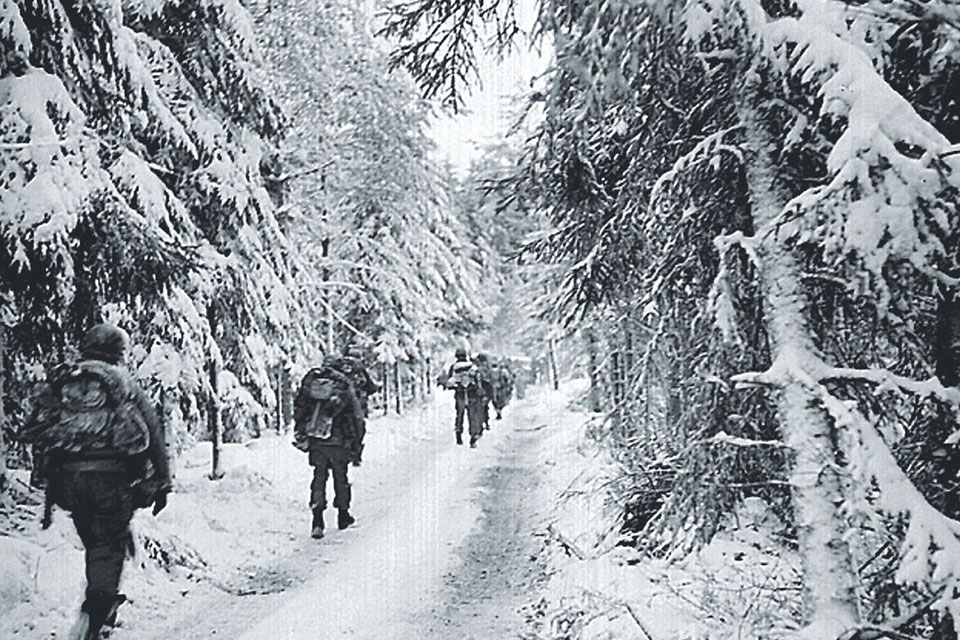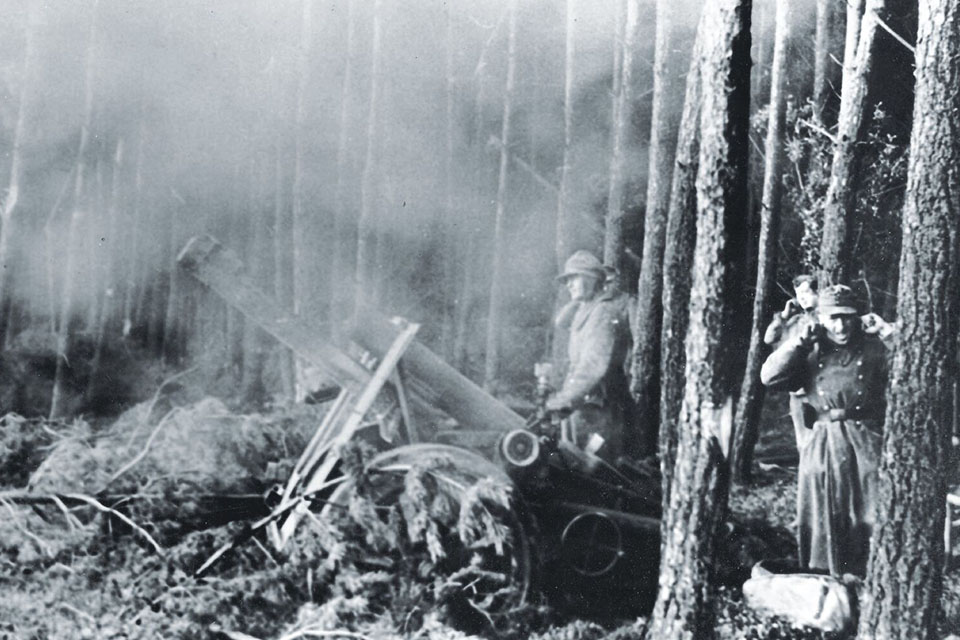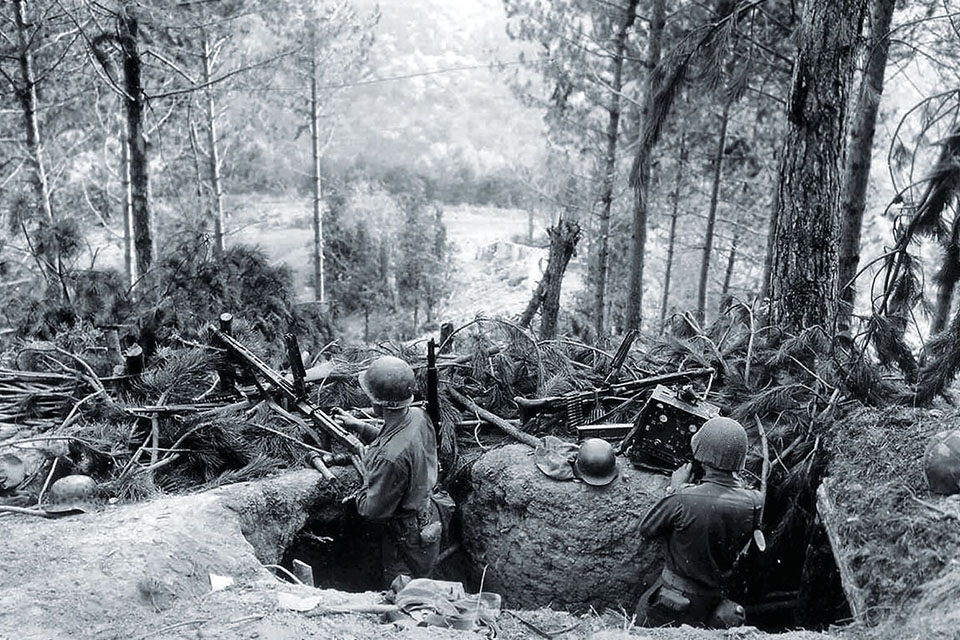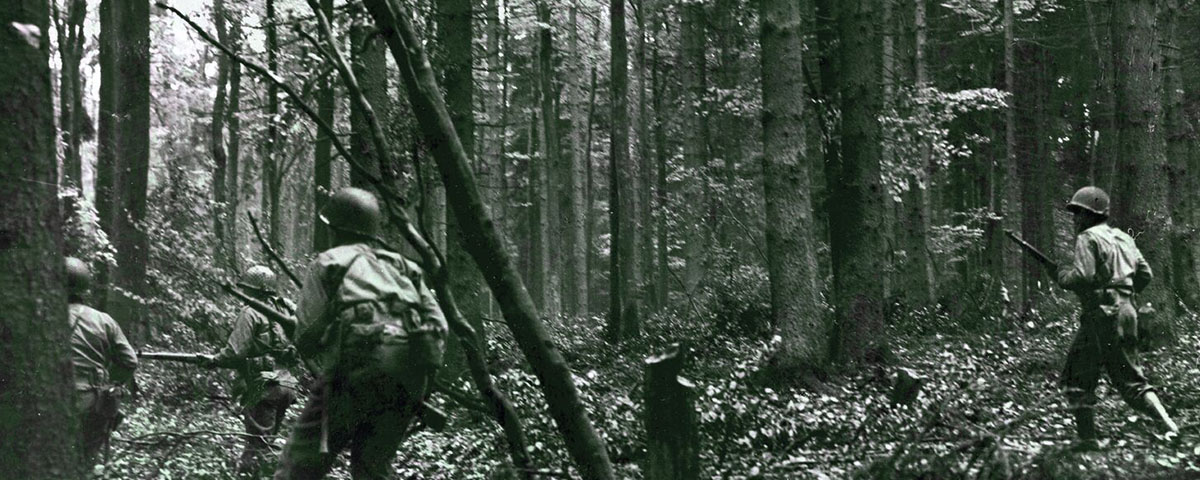American planners who sent GIs stumbling into the Hürtgen Forest in 1944 had their eyes on Germany, not on the perils before them
Gray clouds hung low, and a steady drizzle dripped through the tall fir trees of the Hürtgen Forest along the German-Belgian border early on the morning of Thursday, Nov. 16, 1944. As sporadic artillery volleys thumped in the distance, batches of shivering German soldiers ventured from the forward foxholes and bunkers of Lt. Gen. Hans Schmidt’s 275th Infantry Division, scouting for signs of an expected American attack. Less than a mile away men of the 22nd U.S. Infantry’s rifle and weapons companies rolled up their blankets and ate breakfast.
Commanding the regiment was 42-year-old Colonel Charles T. “Buck” Lanham, a wiry, graying graduate of West Point’s Class of 1924 who led from the front and expected the same of subordinates. The 22nd was responsible for a three-mile front in the Hürtgen, a 50-square-mile inverted triangle of trees roughly bounded by the German towns of Aachen to the west, Düren to the east and Monschau to the south.
When all was ready shortly after noon on November 16, the 22nd Infantry’s lead companies waded across the Roter Weh stream and began climbing a fir-clad ridge toward the Rur River plain some five miles ahead. Writer Ernest Hemingway, a friend of Lanham’s attached to the regiment as a correspondent for Collier’s, described the forthcoming campaign as “Passchendaele with tree bursts,” while historian John S. D. Eisenhower wrote that the battle “stands in history comparable to the Argonne in World War I.”
By the time it ended, most of Lanham’s men would be dead or wounded.
Stretching from mid-September 1944 to mid-December 1945, the Hürtgen Forest Campaign was part of a drive by Lt. Gen. Courtney Hodges’ U.S. First Army to cross the Rur River and capture its vital dams. The aim was an attack on the Aachen-Cologne axis, designed to close on the Rhine, as a first step toward the envelopment of Germany’s Ruhr Valley. The fighting was bitter because the two dams within the forest controlled the level of the Rur flowing north, and the Allies could not launch a broad assault across the Cologne plain to the Rhine as long as the enemy could threaten to flood them out.
The Allies were eager to breach the German border defenses, cross the Rhine and push into the Reich, but barring the way was the Rur and the woodland south of Aachen. The attack corridor was narrow and ill-suited to large-scale maneuvering. Yet Hodges and VII Corps commander Maj. Gen. J. Lawton Collins decided it was necessary to clear the Hürtgen Forest. “If we would have turned loose of the Hürtgen and let the Germans roam there,” Collins later explained, “they could have hit my flank.”
In their haste to enter Germany, the Americans underestimated this major obstacle—a strongly defended forest with dense trees, deep ravines and a dearth of roads. Collins and Hodges made no plans to capture the hydroelectric and flood-control dams just inside the forest. It would be too perilous to send troops across the Rur while the enemy controlled the dams. They were the key, but it would take a hard fight in the forest by several divisions before Hodges ordered an attack against them.
Within the forest, solidly dug in with 1,000 concealed guns and plenty of ammunition, were the men of General Erich Brandenberger’s Seventh Army, General Gustav-Adolf von Zangen’s Fifteenth Army and General Hasso von Manteuffel’s Fifth Panzer Army.

Maj. Gen. Maurice Rose’s 3rd Armored Division fought the initial engagements in the forest in September 1944. Following it were the 9th and 28th infantry divisions and numerous support elements, which hammered into the German pillboxes and bunkers with little success. Fed piecemeal into the cauldron behind them were reinforcing combat units, including the 1st, 8th, 78th and 83rd infantry divisions, the 5th Armored Division, the 505th and 517th parachute infantry regiments, and the 2nd Ranger Battalion, led by Lt. Col. James Earl Rudder of Pointe du Hoc D-Day fame.
The opening series of assaults were ill-fated and reflected little credit on senior American commanders. The primary objective, to protect Collins’ flank, was limited, and senior officers initially failed to recognize that control of the Rur dams would enable the Germans to flood out any advances north. The Hürtgen was valuable territory to the enemy, as its loss would threaten their entire defensive line west of the Rhine.
The American high command blundered by not proposing an easier avenue of approach southeast of the forest, allowing Hodges’ army to seize the dams and then clear the difficult terrain downriver. As undertaken, the offensive placed the Americans at a severe disadvantage in the forest. The Germans were able to delay and wear them down, buying critical time in which to prepare for the imminent Ardennes counteroffensive.
The Americans had stumbled into a tactical nightmare. Launching an attack on October 6, two U.S. regiments fought for five days to advance scarcely a mile to the first forest clearing. It then took the 9th Infantry Division another 10 days of intensive action to push another mile. The 2-mile advance cost the Americans almost 5,000 casualties. More divisions, including Maj. Gen. Norman Cota’s long-suffering 28th, entered the maelstrom, and losses continued to mount.
The truculent Hodges did not press air attacks on the dams until late November, and they failed. The bombers hit their targets, but damage to the massive concrete structures was negligible. On Dec. 13, 1944, three months after the first GIs entered the Hürtgen Forest, the Americans finally launched a ground assault on the dams. But not until February 1945 did Hodges wrest control of the dams and with confidence place troops on the east bank of the Rur.
The campaign was strictly a foot soldier’s fight, as the dense woods, ravines, steep ridges, lack of roads, mud and weather—rain, fog, sleet, snow—negated U.S. superiority in armor and airpower. Only late in the battle could tanks be deployed, leaving it to the infantry to decide the outcome. In the end it was only sheer guts that propelled them through the forest. The campaign eventually absorbed elements of 17 divisions, resulted in dreadful casualties and sorely tested troop morale. It was one of the U.S. Army’s worst reverses in the European theater. GIs faced no greater odds under such harrowing conditions during the war than did the riflemen, machine gunners and mortar crews who battled through the Hürtgen Forest.
The “Double Deucers” had landed at Utah Beach with Maj. Gen. Raymond O. Barton’s 4th Infantry Division on June 6, 1944. Though the regiment suffered heavy casualties at Normandy, morale remained high, and it ranked as one of the U.S. Army’s best infantry units. Captain William S. Boice, one of the regimental chaplains, called the 22nd Infantry “a fighting machine trained to an efficiency not matched at any time during the war.”
Like many units engaged in the Hürtgen, the Double Deucers fought longer than normally expected, and few American combat outfits have ever experienced such severe casualties. Within three days the regiment lost its three battalion commanders, and the attrition rate among rifle company leaders was more than 300 percent. On the sixth day alone, the casualty rate was 50 percent, and by the night of November 20, the rifle companies had lost more than 40 percent of their strength. Yet Lanham’s men fought on another 12 days.
Despite heavy artillery support, the regiment suffered 2,678 casualties while advancing just 6,000 yards during 18 continuous days of action. One soldier fell for every 2 yards gained. The unit’s casualty rate was a staggering 82 percent of its normal strength of 3,257 officers and men.

“The forest was a helluva eerie place to fight,” recalled Tech. Sgt. George Morgan, of the regiment’s 1st Battalion. “You can’t get all of the dead, because you can’t find them, and they stay there to remind the guys advancing as to what might hit them. You can’t get protection. You can’t see. You can’t get fields of fire. Artillery slashes the trees like a scythe. Everything is tangled. You can scarcely walk. Everybody is cold and wet, and the mixture of cold rain and sleet keeps falling. Then they jump off again, and soon there is only a handful of the old men left.”
Shells bursting in the crowns of 100-foot fir trees and mines erupting from the forest floor made life hellish for the American soldiers. A tree burst would send shrapnel and timber raining down, and foxholes proved scant shelter. Many GIs fell victim to their own artillery salvos.
Minefields proved especially tricky to navigate. Engineers might mark cleared paths with white tape only to have the wind carry it away or snow and mud obscure it. When U.S. armor did finally come up to support the infantry, the minefields and dense trees forced the tanks to stick mainly to the few narrow, muddy forest roads and logging trails. But the roads were also mined, and a single disabled tank or truck could block an entire column.
In addition to the enemy and harsh weather, the Americans battled exhaustion, hunger, pneumonia and trench foot. They lacked adequate boots and winter clothing, and many searched in vain for a dry place in which to sleep. Men in forward companies spent long nights half-frozen in open foxholes. And to the astonishment of British troops in the area, the GIs subsisted on cold C-rations.
“What surprised us,” one British officer recalled, “was the apparent indifference of the American commanders to the physical needs of their men in winter warfare. In these conditions, hot food once a day is as vital as ammunition. In the first few days the infantrymen of the 84th Division were expected to exist on packets of odd items such as eggs and bacon compressed into tablets, gum and candy, with nothing hot to drink. Men fight with greater cheerfulness even on the cheapest form of pig’s belly of transatlantic origin masquerading as bacon, if hot, or the bully beef and tea and biscuits which maintained the British. They also need a pair of dry socks every day.” (Trench foot alone sidelined hundreds of men of the 84th Infantry Division.)
Overcoats soaked with water and caked with frozen mud became too heavy to wear, and moisture seeped into radio sets, rendering them useless. The forest floor was so tangled with brush and debris that men collapsed under the physical strain of carrying weapons, bringing up supplies and evacuating the wounded.
The fighting was often at such close quarters that hand grenades proved the only decisive weapons. Booby traps in abandoned foxholes and ditches turned potential sanctuaries into graves for the unwary. The Germans even rigged explosives beneath American casualties. One seriously wounded GI lay motionless atop a booby trap for 72 hours, struggling to remain conscious so he could warn whoever might come to his rescue. Someone finally did, and the man survived. As the living strove to survive, the bloated, frozen dead—beyond all such caring—lay strewn in grotesque positions.
The village of Hürtgen changed hands 14 times during the campaign, Vossenack eight times. In at least one U.S. infantry battalion morale crumbled under the strain, three company commanders losing their nerve and their commands over a four-day period. All the officers of one rifle company were relieved or broke down, one platoon leader facing arrest for having flatly refused to lead his men into battle. Soldiers of all ranks collapsed.
Hürtgen reflected the best and worst in the American foot soldier. Several men earned the Medal of Honor, while many other acts of gallantry never came to light. But there were also instances in which fear paralyzed men who had seen more action than they could stomach. Some GIs ran, even in the absence of enemy troops. Others refused to move without armored support, while some tank crews refused to advance without infantry protection.
The human toll was staggering. Of the 120,000 U.S. troops that participated in the Hürtgen campaign, an estimated 24,000 were killed, wounded or captured. Combat fatigue, pneumonia and trench foot claimed another 9,000, bringing the casualty rate to nearly 30 percent.

The Hürtgen nightmare dragged on into mid-December 1944, when the Americans received orders to withdraw.
Because it was so disastrous, and since most people opt only to remember their nation’s victories, the grueling campaign has been largely forgotten. Overshadowed by both the September 1944 abortive Allied invasion of Holland (Operation Market Garden) and the December 1944–January 1945 Battle of the Bulge, the Battle of Hürtgen Forest was accorded only brief mention in memoirs and overlooked by most historians.
When the firing finally stopped, all the Americans had to show for their sacrifices were a few miles of shell holes, tree stumps and shattered buildings. Once the appalling losses came to light, participants and high-ranking officers alike questioned the necessity of the campaign.
“It seemed to me,” reflected Lt. Col. Frank L. Gunn, commander of the 2nd Battalion, 39th Infantry Regiment, “the Hürtgen Forest could have been contained rather than assaulted, and a large flanking or encircling movement performed by corps. This would have reduced the casualties and still have accomplished the mission of capturing the dams on the Rur River.” Lieutenant William Burke of the 803rd Tank Destroyer Battalion echoed that sentiment: “Some of us with combat experience from the beaches to Hürtgen were hard-pressed to understand the tactical wisdom of slogging it out in such an unforgiving environment instead of bypassing it.”
The operational plan even baffled the enemy. “The German command could not understand the reason for the strong American attacks in the Hürtgen Forest,” recalled Maj. Gen. Rudolph von Gersdorff, chief of staff of the German Seventh Army, who twice plotted to assassinate Adolf Hitler yet, improbably, served out the war in uniform. “The fighting in the wooded area denied the American troops the advantages offered them by their air and armored forces, the superiority of which had been decisive in all the battles waged before.”
Yet despite all the criticism and Monday morning quarterbacking, during the costly three-month strategic blunder the U.S. infantry somehow managed to maintain unit integrity and persevere. While the high command inevitably came under criticism, there was no questioning the heroism of the GIs in the foxholes. The historian of Britain’s crack Guards Armored Division, which swapped officers and men with U.S. units, offered this praise of the Americans: “Their methods might be somewhat different from ours and even seem curious and unorthodox, but there could be no doubt about the excellent results when they were put into practice. Divisions…[that] fought in this battle could have challenged comparison with the finest of our own.”
The struggle for the Hürtgen Forest seriously weakened Hodges’ First Army, leaving its extended front line unable to resist the German onslaught in the early hours of the Battle of the Bulge. Cota’s 28th Division was still recovering in northern Luxembourg when hit by Field Marshal Gerd von Rundstedt’s advance columns that December 16. The 1st and 9th infantry divisions had to depend almost entirely on replacement troops after Hürtgen, and the 4th and 8th also had major manpower gaps to fill. The 2nd Ranger Battalion and 517th PIR emerged from the bloody forest battle in a nearly skeletal state.
In early February 1945, British and Canadian troops replayed aspects of the Hürtgen campaign in Operation Veritable, as Field Marshal Bernard Montgomery’s 21st Army Group closed on the Rhine. The offensive in the Reichswald—the northern anchor of the Siegfried Line—involved fierce fighting in heavy rains and took more than a month. Like the clash for the Hürtgen, Monty’s campaign echoed the Western Front bloodbath of World War I and was thus overlooked by most historians.
The men who fought and died in the woods deserve at least a reflective look.
British army veteran Mike Hull is a freelance writer and historian based in Enfield, Conn. For further reading he recommends A Dark and Bloody Ground, by Edward G. Miller, and Hell in Hürtgen Forest, by Robert Sterling Rush.





